A Ball of Fluff Called Equinox
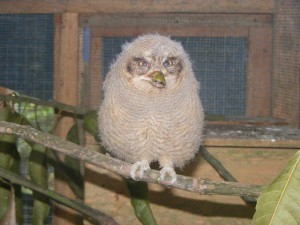
By Jack Ewing
Equinox is a Latin word meaning “equal night.” Twice each year, when the sun shines directly over the equator, day and night are the same length all over the globe. These two dates are called the March equinox and the September equinox. The March equinox, which marks the beginning of spring in the northern hemisphere, always falls on March 20 or 21, and the September equinox, which marks the beginning of fall, always falls on September 22 or 23. The March equinox in the year 2009 fell on March 20, and that was the day that a little ball of fluff came walking into my office at 6:30 in the evening just as I was thinking about closing up and going home. It was obviously a very young owl, nearly ready to fledge, but not yet able to fly. We had heard an owl calling near the office on quite a few occasions, and I surmised that this youngster had fallen out of it’s nest, and that its chances of getting back were almost nil.
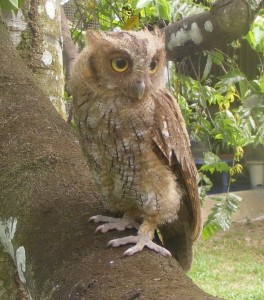
Normally I believe that it is best to let Mother Nature deal with her own creations. Her ways may sometimes seem harsh to us, but if a baby is separated from its mother and destined to die, nature has a good reason. I don’t feel we should interfere in this process. But this cute little ball of fluff was too much for me. I couldn’t bring myself to shoo it out of the office and into the cruel world. Instead, I called my wife Diane, who totally disagrees with my philosophy about survival of the fittest, and asked if she would be interested in trying to rescue a helpless baby owl. “Do you have to ask?” She replied. “Bring him over.”
By the time I arrived home Diane had already called an ornithologist friend and had figured out what to feed the fledgling, mostly small chunks of meat. Owls are 100% carnivorous and eat only animal protein. Though we had no idea what sex the owl was, we somehow assumed that it was a he and began calling him “Equinox.” Later that was shortened to “Iggy.”
With help from Charlie, the ornithologist, we determined that Iggy was a screech owl of which there are three possibilities, Vermiculated Screech Owl, Pacific Screech Owl, and Tropical Screech Owl. All are small, less than 25 centimeters (nine inches) tall, and all are found in this region. We wouldn’t know for sure until Iggy had his adult plumage.
Charlie explained that chunks of meat were not enough. Young owls eat mostly insects that their parents bring to them, and which they later learn to hunt for themselves. He said that wing and body parts had plenty of nutrients that weren’t available in raw meat, and that these are essential for the young owl’s digestion and development. We began capturing crickets and grasshoppers which we held out to Iggy until he grabbed them with his claw and stuffed them into his mouth. (see photo) Within a couple of weeks we were turning them loose in his cage, and he hunted and killed them by himself. Our overall objective was to teach Iggy to survive in nature and liberate him into the wild.
Charlie said Iggy needed mice in his diet too, with hair, skin, bones and all. He said that the parent birds would sever chunks of mice with their beaks and feed them to the young. Diane became a regular customer at the only pet shop in San Isidro that sold white mice. Before long she had a couple of cages full of mice and was raising her own. Charlie said that the most humane way of sacrificing the mice was to freeze them to death, so we would put several at a time in a plastic jar and stick it in the freezer. Later we cut them into slices, which I called mouse chops, and which soon became Iggy’s favorite food. Within a month Iggy was ready to start killing his own mice. At first he was pretty clumsy and the mice suffered the consequences of his inexperience, but after a few tries he learned to dispatch them with a quick bite to back of the neck. By this time he had all of his flight feathers and easily maneuvered around his large cage.
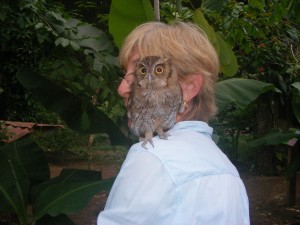
During all of this time we were getting to know Iggy, and he was getting to know us. Owls have so many facial expressions and mannerisms that we tend to imagine that we know what emotion they are experiencing, happiness, sadness, fear, indifference, curiosity, disapproval, or anger. In reality, we probably don’t have any idea what is going on in the owl’s head. One thing that is clear is that he liked Diane. He loved to sit on her shoulder and preen her hair, as if it were feathers. As he grew older his repertoire of sounds increased. As the name “screech owl” implies they can emit a pretty loud screech. The call is however in no way unpleasant, unless, of course, it comes from nearby at 2:00 AM when you are sound asleep. At first his voice reminded me of that of an adolescent boy, but within a month he was calling just fine. In addition to the screech Iggy made a number of other calls including a twittering sound that seemed to mean he was happy.
Diane eventually agreed that it was time to begin the liberation process. We started by taking Iggy outside and setting him down on a tree limb. (see photo) He looked around a lot, swiveling his head more than 180 degrees, but didn’t attempt to fly away. Diane stayed nearby, and he always jumped back on her shoulder when he had had enough of the great outdoors.
After a couple of weeks of this Diane took him over to the butterfly garden, a large tent like area covered with netting. He was plenty old enough to fly, but hadn’t had much practice. His cage was a good size, but too small to permit extensive flying. The butterfly garden, at 16 meters by 16 meters (52 feet by 52 feet,) was a perfect place to practice. There were lots of posts, plants, and guide wires that had to be avoided, making the learning experience even more realistic. At first Diane only left him there during the day and took him home at night. Later he stayed there day and night. She mounted a box up high where he could take shelter when it rained. About every third day she would take him a live mouse and put it in a large open topped enclosure on the ground. The mouse could run around but couldn’t get out of the enclosure. This hunting practice was crucial if he were ever to live in the wild and fend for himself. A group from the Birding Club of Costa Rica and their ornithologist guide saw him in the butterfly garden and positively identified him as a Tropical Screech Owl (Megascops choliba,) a species which is found from Brazil to Costa Rica and is fairly common in our region.
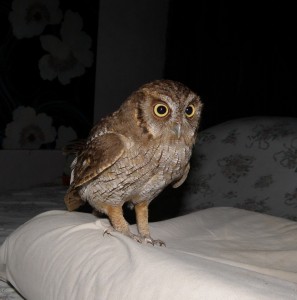
The next step was to give Iggy total freedom of movement. Iggy was free to fly anywhere he liked, but there was a place in our garden where he knew that Diane would place a few chunks of meat at the same time every afternoon. She moved the mouse enclosure over to same place and gave him a mouse now and then until the mice were all gone. As time passed Iggy came less and less for free handouts, and eventually gave it up altogether. Iggy decided that he would sleep in our bedroom during the day. Diane placed a cardboard box up high in a corner where he would have a little protection. It was during this period that I learned how truly amazing owls are. Iggy could be sitting in the box with his eyes closed, and a cat would quietly tip-toe into the bedroom on the ceramic floor without making a sound. In an instant the owl was on full alert. It only took a couple of dive bombing attacks on the cats to teach them to stay out of the bedroom. Iggy always left about dark. Sometimes he would come into the house to hunt insects and sometimes he stayed out all night. He usually came flying into his box around 4:30 AM occasionally announcing his arrival with a loud screech.
When people try to raise wild animals the animals never become domesticated; they only lose their fear of humans. As they mature, are better able to fend for themselves, and lose their dependence on humans, instincts take over and the wildness dominates their behavior. This happened with Iggy. There were days he didn’t come to the bedroom to roost, and when he did, he started showing aggressive behavior toward humans. After several dive bombing attacks on Ana, the girl who helps Diane around the house, and one on Diane, we took the box down. Iggy got the idea right away and found a place outside where he could sleep during the day. He often came into the house at night to hunt insects, occasionally screeching in the wee hours of the morning, but all of the aggression was gone. Perhaps, to his way of thinking, the attacks were a defense of his roosting box.
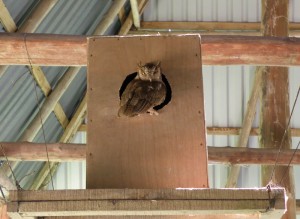
The biologist suggested that we build a nesting box and gave Diane the design. The box was 35 centimeters by 50 centimeters (14 inches by 20 inches) and had a hole the size of a baseball in one wall, just large enough for an owl to slip through. We mounted it out on the porch. By this time it was early in the year 2010, and it would take a year before Iggy showed any interest in the box.
During that year we heard him call almost every night, sometimes from out in the garden and at others from our front porch, where the nesting box was located. Eventually we got the idea that there were two different owls calling, but there was still no sign of interest in the box. On many mornings there was a telltale white spot or two on the living room floor attesting Iggy’s nocturnal visits. Once in a while he would come inside to hunt in the evening while we were reading or watching TV, but there was no physical contact. Iggy was definitely wild, albeit with an affinity for our house, both inside and out. Around Christmas of 2010 was the first time we saw two owls together. Later we saw signs that they were investigating the nesting box.
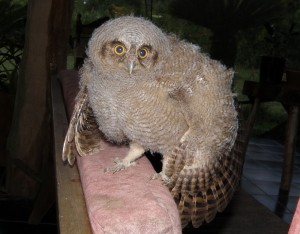
On the evening of March 18, 2011 about 5:00 PM, I walked into the storeroom at the office and came face to face with another ball of fluff, a dead ringer for Iggy when he first appeared, an practically in the same place. This one was on a chair. Vanessa, the receptionist, spotted a second ball of fluff on one of the shelves, and the following day a third one appeared. The day after that the mother owl started appearing with the fledglings in the late afternoon. It was then that everything became clear. We hadn’t really rescued Iggy at all on the equinox of 2009, rather we had kidnapped him from his mother, and taken him on a strange adventure that few owls will ever experience. The mother owl had made her nest in a secluded cubby hole in the ceiling of the storeroom. When the chicks started to fledge was when we started noticing them on the floor, the furniture, and the shelves of the store room. One evening we saw all three of them sitting in a tree outside the office with their mother just at dusk. That was the last time we ever saw them.
By this time, back over at the house we were seeing lots of activity on our front porch around the nesting box. With tropical screech owls, the male chooses the nesting site and claims it as part of his territory. The female decides which male she will mate with, in part, on the basis of the desirability of his nesting site. I like to think that his sexiness has something to do with it as well. Anyway, here is where things start losing clarity, because now we aren’t sure if Iggy is a male who convinced a female to nest in his box, or if Iggy is a female who sweet-talked a male into accepting her choice for a nesting site. What is clear is that two owls, one of whom was most certainly Iggy, nested in the box.
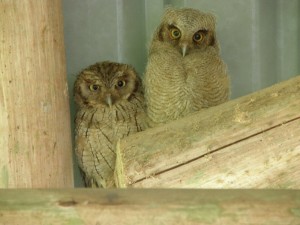
On Sunday, July 3, 2011, I got up as usual at 5:00 AM, opened the doors onto the porch, and came face to face with a ball of fluff standing on an old couch (see photo) we have out there. It was more mature than Iggy when he/she first appeared in the office. This ball of fluff had enough feathers that it could fly up into the rafters where it was joined by an adult owl (see photo) who may or may not be Iggy. Every day they moved to a different place, but always on the porch. When Diane walked out onto the porch the adult twittered at her like Iggy always did. At night the adult owl went out, hunted and took insects back to the baby, who I call junior. On the sixth night they both disappeared. I imagine that the adult is carrying out the education of junior. It will be interesting to see if the adult owl teaches junior to hunt in the house in addition to hunting in the wild. It would appear that by kidnapping Iggy back in 2009 we have created a generation of owls with an affinity for human homes. This custom, in part, was begun by Iggy’s father, who charmed his mother and convinced her to nest in the office storeroom. Had she nested out in nature where most owls do, this story would never have been told.


Excellent story! Thanks